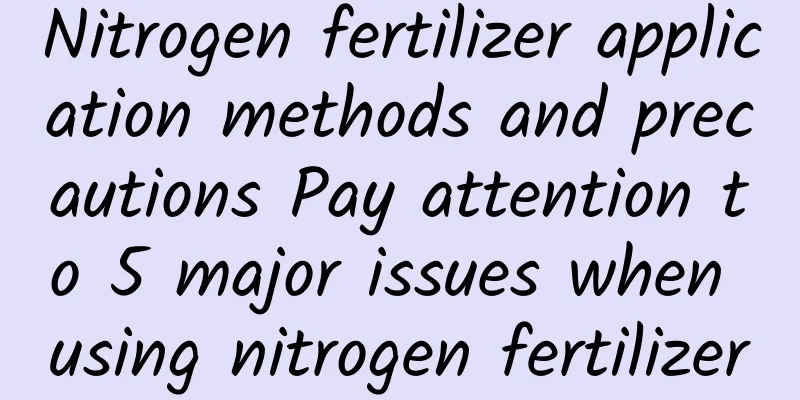Nitrogen fertilizer application methods and precautions Pay attention to 5 major issues when using nitrogen fertilizer

|
Nitrogen fertilizer is generally used as topdressing, and the depth of fertilization should be about 10 cm. Note that nitrogen fertilizer must be applied deeply and fully mixed with the soil, so that it can reduce volatilization, be absorbed by crops, and expand the nutrient area. Moreover, nitrogen fertilizer cannot be mixed with alkaline fertilizers and alkaline substances, otherwise the effect will be weakened. The following specific locations introduce what issues should be paid attention to during the use of nitrogen fertilizer. Treat various nitrogen fertilizers differently according to their characteristicsAmmonium bicarbonate and ammonia water are easy to volatilize and release ammonia, so they are suitable for deep application as base fertilizer . Nitrate nitrogen fertilizer has strong mobility in the soil and fast fertilizer effect, so it is a good topdressing fertilizer for dry fields. Ammonium nitrogen fertilizer or urea can be used as topdressing fertilizer for general paddy fields. In arid areas with less rainfall, the leaching problem of nitrate nitrogen fertilizer is not prominent, so it is more appropriate to apply nitrate nitrogen fertilizer. In rainy areas or rainy seasons, it is better to apply ammonium nitrogen fertilizer and urea. Deep nitrogen fertilizer applicationNitrogen fertilizer should be applied at a depth of about 10 cm and fully mixed with the soil. Deep application of nitrogen fertilizer can reduce the loss of fertilizer in direct volatilization, loss with water, nitrification and denitrification. Deep fertilization is also beneficial to the development of the root system, allowing the root system to grow deeper and expand the nutrient area . Reasonable application of other fertilizersWhen returning straw or green manure to the field or applying uncomposted organic fertilizer, chemical nitrogen fertilizer should be applied in combination, which plays an important role in achieving high and stable yields of crops and reducing costs. This can not only better meet the nutrient needs of crops, but also improve soil fertility. The combined application of nitrogen fertilizer and phosphorus fertilizer can improve the utilization of both nitrogen and phosphorus nutrients . According to the target yield of the crop and the nitrogen supply capacity of the soilDetermine the reasonable amount of nitrogen fertilizer, and reasonably control the ratio of base fertilizer and topdressing and the amount of nitrogen fertilizer applied during the application period, which will directly affect the amount of nitrogen available for crops to absorb. Within a certain range, crop yield and NO3 content increase with the increase of nitrogen fertilizer application. Therefore, the fertilization period and fertilization method should be as scientific and reasonable as possible . Maintain good soil moisture when applying nitrogen fertilizerThe main way for roots to absorb nitrogen is mass flow, accounting for 75% to 85%, diffusion accounts for 10% to 14%, and interception accounts for only 6% to 10%. If the soil moisture is poor, it is difficult or even impossible for the roots of crops to absorb nutrients, and fertilization is a waste. Therefore, when applying nitrogen fertilizer to plots with poor soil moisture, water should be applied in time . |
<<: What crops are suitable for planting in March? What crops can be planted in March?
Recommend
How to propagate soapberry trees and what to pay attention to
How to reproduce the honeysuckle tree The main me...
How to propagate oil lily
How to propagate oil lily Division method Plantin...
Can I grow lilacs at home?
Can I grow lilacs at home? You can plant lilac fl...
How often should I water my Kylin palm?
How often should I water my Kylin palm? The water...
Cultivation methods and precautions of Trachelospermum erythrorhizon
Trachelospermum jasminoides is particularly easy ...
Pepperwood pest control
Prevention and treatment measures Preventing pest...
How to prune the branches of small-leaf red sandalwood? Tips for pruning small-leaf red sandalwood bonsai (with pictures)
Generally speaking, the pruning of red sandalwood...
How to plant jasmine
1. Cutting There are no strict requirements on th...
What to do if geranium only grows leaves but does not bloom
1. Increase lighting Reason: Geraniums need suffi...
What should I do if the leaves of Ruyi Queen become soft and droopy?
1. Watering in time Reason: Queen Ruyi is afraid ...
Are figs suitable for growing indoors?
1. Is it suitable for indoor breeding? Under norm...
Bonsai production and maintenance of Pinus truncatula
Preparation method Choose basin shape The specifi...
How to care for Clivia in summer
1. Sunshade and ventilation After entering summer...
What to do if Qilin is watered too much
Overwatering If you often water the Kirin too muc...
What to do if the leaves of the flower 'Smooth Sailing' droop
1. Proper shade Reason: The plant cannot be expos...









